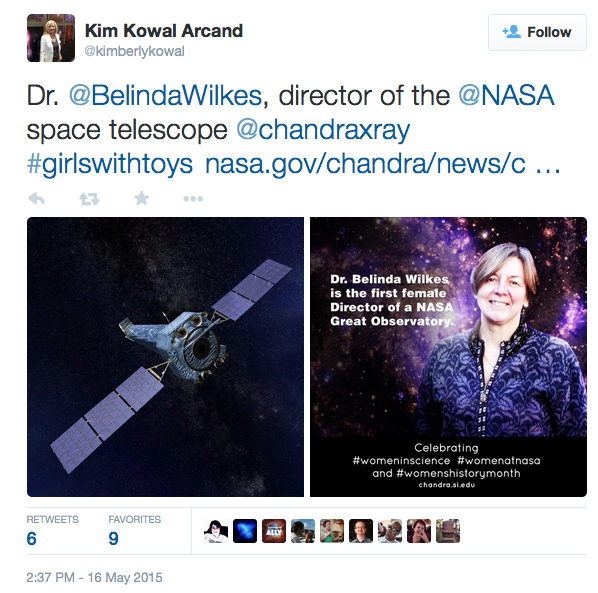Submitted by chandra on Mon, 2016-06-13 09:21

Micro to macro
Illustration: NASA/CXC/K.Divona
When people ask me what I do for work, I often say that I’m a storyteller. It’s not that I stand on a stage with a microphone and narrate long tales to a rapt audience.
My stories are told differently, not through voice or music, but through lines of code and technical applications. They are stories, of science.
As an undergraduate, I began my career in molecular biology, looking at the tiny organisms that can transmit Lyme disease to humans aboard the Ixodes Scapularis (a.k.a., the Deer tick). But by the time I graduated, I was moving on to learn about another type of science: that of computers.
Submitted by chandra on Mon, 2016-05-16 08:27

Images of our shared Universe provide snapshots of various phases of life and death, and different physical phenomena, found in locations across the cosmos. Modern telescopes allow us to “see” what the human eye cannot. This new generation of ground- and space-based telescopes has created an explosion of images for people everywhere to explore.
The Aesthetics & Astronomy project studies the perception of multi-wavelength astronomical imagery and the effects of the scientific and artistic choices in processing this astronomical data. The images come from a variety of space and ground-based observatories, including NASA’s Chandra X-ray Observatory and Hubble Space Telescope. Studies such as these can benefit astronomy across the electromagnetic spectrum of astronomical images, and may help visualization of data in other scientific disciplines.
Submitted by chandra on Thu, 2016-02-18 22:27
On February 17th, the Japanese Aerospace Exploration Agency (JAXA) launched a rocket into space with the X-ray Astronomy Satellite, also known as ASTRO-H, onboard.

Credit: NASA
Shortly thereafter, ASTRO-H separated from the spacecraft and deployed its solar panels. Operators then received data transmitted from the satellite and received at the Uchinoura ground station in Japan. All reports are that the satellite is currently in good health.
Submitted by chandra on Thu, 2016-02-11 11:41
It's a fitting coincidence. Just a few months after celebrating the 100th anniversary of Einstein's theory of General Relativity (GR), we have just heard that gravitational waves, a key prediction of GR, have been directly detected for the first time. The February 11th, 2016 announcement by the Laser Interferometry Gravitational-Wave Observatory (LIGO) team is one of the most important moments in the history of astrophysics. Here, I discuss how observations with NASA’s Chandra X-ray Observatory and other traditional observatories help complement the detection and study of gravitational waves.

Figure 1: The LIGO Hanford Observatory. Credit: Caltech/MIT/LIGO Observatory
Gravitational waves are produced by violent events, such as the collisions and mergers of neutron star or black hole pairs, or the collapse and explosion of massive stars in supernovas. As a September 2015 news release by LIGO eloquently explains,
Submitted by chandra on Mon, 2015-08-31 11:32
Welcome to the latest installment of the Carnival of Space, a weekly round up of astronomy news co-hosted on various space science blogs. It’s a pretty big Universe out there so let’s get started!

Submitted by chandra on Wed, 2015-08-26 09:55

Sixteen years ago today, the first images from the newly-launched Chandra X-ray Observatory were released to the public. While these images were spectacular themselves, they also represented the promise of the amazing things that Chandra might be able to do in the future.
Submitted by chandra on Tue, 2015-07-14 06:59
On July 14th, the New Horizons spacecraft will fly by Pluto during its unprecedented mission to the outer Solar System. In addition to the data gathered by New Horizons and its suite of instruments, other telescopes – including the Chandra X-ray Observatory – will be pitching in to help astronomers learn more about this distant and icy world.

Artist conception of New Horizons Spacecraft.
Credits: Johns Hopkins University Applied Physics Laboratory/Southwest Research Institute
Submitted by chandra on Tue, 2015-05-19 15:11
There have been so many excellent images and messages being tied to the hashtag #girlswithtoys on Twitter over the past several days. We would love to be able to take some selfies with some of the many female scientists, engineers, and other professionals who use and run the Chandra X-ray Observatory. (Of course, the Director of Chandra is Belinda Wilkes, the first woman to lead one of NASA’s Great Observatories) Unfortunately, Chandra is currently in its highly elliptical orbit that takes it a third of the way to the Moon, so the spacecraft is unavailable for a snapshot.

Submitted by chandra on Thu, 2015-04-23 12:33
If you are at all interested in astronomy, chances are you’ve heard that the Hubble Space Telescope is celebrating its 25th anniversary this week. What some people may not know is that Hubble is one of four siblings, so to speak. Back in the 1980s, NASA commissioned the"Great Observatories," each designed and built to study different wavelengths of light.
The four Great Observatories, in order of their launches that took place between 1990 and 2003, are Hubble, the Compton Gamma Ray Observatory, the Chandra X-ray Observatory, and the Spitzer Space Telescope. You can learn a little more about each of these telescopes here: http://www.nasa.gov/audience/forstudents/postsecondary/features/F_NASA_G...

Submitted by chandra on Mon, 2015-03-23 10:52
Steve Hawley was the flight engineer on the STS-93 Columbia mission that carried Chandra into space in 1999. Before that he was on four previous shuttle flights, one in 1990 to deploy the Hubble Space Telescope, and one in 1997 to assist in making major upgrades and repairs to Hubble. His role in the deployment of two of the most productive telescopes ever has secured him an important place in the history of astronomy.
At a recent symposium celebrating 15 years of Chandra Science, Steve sat down over breakfast to talk about his illustrious career so far, and plans for the future.
 Steve Hawley
Steve HawleyWhen did you first think you wanted to be an astronaut?
SH: I wanted to be astronomer since I was very young. My grandfather taught physics at a small college in Kansas. He used to say, "In physics, you learn how to think." In astronomy you can learn how the universe works just by looking. And I was drawn to become an astronaut NASA, because NASA is a great organization because they try to do things that have never been done before.
Pages